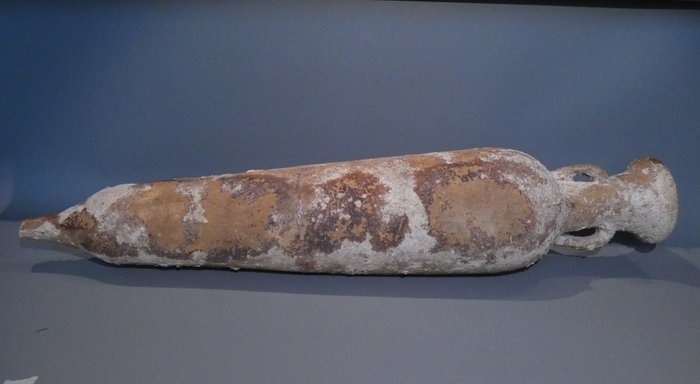Late Roman/Early Byzantine Terracotta Huge Spindle-shaped amphora, Spatheion type. 72 cm large. 4th - 7th century AD.
Roman spindle-shaped terracotta amphora (Spatheion type) . \r
\r
Late Roman/Early Byzantine, 4th - 7th century AD\r
\r
Terracotta. \r
\r
72 cm lagre. \r
\r
Good condition: Good, but a breakline rejoined. Small hole at the bottom of the body seems to testify to ancient reuse. Marine concretions, collages. \r
\r
Provenance: Old private collection, France, formed around 1960 - 1970. Found in 1964 off the Croatian coast. \r
\r
Salvaged from the depths of the Mediterranean, this large vessel was lost in some ancient shipwreck. Once filled with the produce of the classical world, it has been transformed into a magnificent marine sculpture, covered with signs of marine life, snails, sponges, molluscs, sea urchins and barnacles. \r
\r
Trade and commerce of the western Mediterranean during the late Republican period of ancient Rome. Its distinctive features, such as the differences in the shape of the rim and the three sub-types, have helped archaeologists to identify and study the distribution of this type of amphora in different regions. \r
\r
And daily life. Many examples of Roman amphorae have been excavated from archaeological sites throughout the . \r
\r
\r
Notes: \r
The seller guarantees that he acquired this piece according to all national and international laws related to the ownership of cultural property. Provenance statement seen by Catawiki. \r
The seller will take care that any necessary permits, like an export license will be arranged. \r
With certificate of authenticity.
View it on
Estimate
Time, Location
Auction House
Roman spindle-shaped terracotta amphora (Spatheion type) . \r
\r
Late Roman/Early Byzantine, 4th - 7th century AD\r
\r
Terracotta. \r
\r
72 cm lagre. \r
\r
Good condition: Good, but a breakline rejoined. Small hole at the bottom of the body seems to testify to ancient reuse. Marine concretions, collages. \r
\r
Provenance: Old private collection, France, formed around 1960 - 1970. Found in 1964 off the Croatian coast. \r
\r
Salvaged from the depths of the Mediterranean, this large vessel was lost in some ancient shipwreck. Once filled with the produce of the classical world, it has been transformed into a magnificent marine sculpture, covered with signs of marine life, snails, sponges, molluscs, sea urchins and barnacles. \r
\r
Trade and commerce of the western Mediterranean during the late Republican period of ancient Rome. Its distinctive features, such as the differences in the shape of the rim and the three sub-types, have helped archaeologists to identify and study the distribution of this type of amphora in different regions. \r
\r
And daily life. Many examples of Roman amphorae have been excavated from archaeological sites throughout the . \r
\r
\r
Notes: \r
The seller guarantees that he acquired this piece according to all national and international laws related to the ownership of cultural property. Provenance statement seen by Catawiki. \r
The seller will take care that any necessary permits, like an export license will be arranged. \r
With certificate of authenticity.



